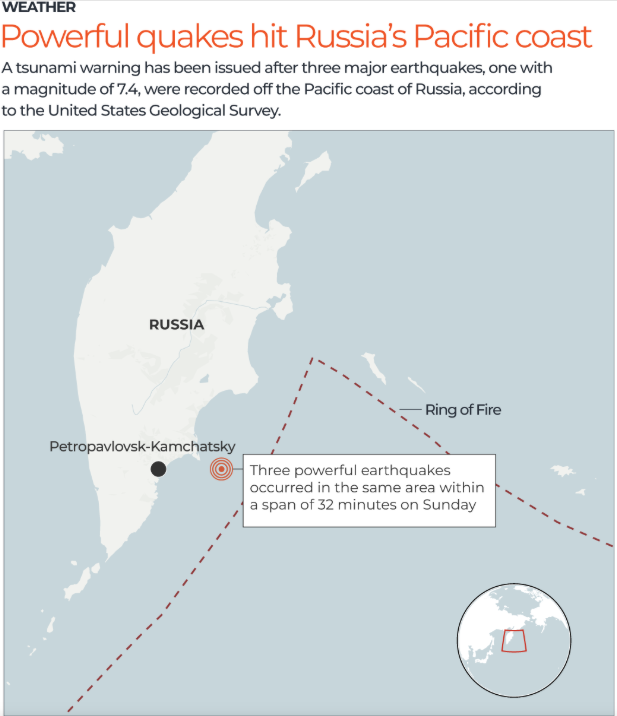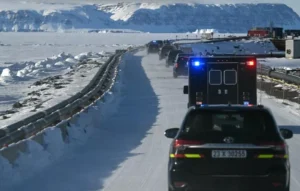A dramatic tsunami alert after powerful earthquakes hit Russia’s Pacific coast as a series of tremors—highlighted by a magnitude‑7.4 quake—shook the seabed near Kamchatka, prompting emergency warnings across Russia and even triggering precautionary watches for Hawaii. This blog post dives deeper with fresh data, expert insight, and historical context to provide a comprehensive snapshot of the event.

What Exactly Happened?
Within just half an hour, the edge of Russia’s Pacific shelf trembled under a trio of undersea earthquakes—a 5.0‑magnitude quake, followed swiftly by a 6.7, and then the headline‑grabbing 7.4 tremor near Petropavlovsk‑Kamchatsky. The U.S. Geological Survey confirms the main quake struck around 144 km (89 mi) offshore at a depth of roughly 20 km, sending seismic shockwaves across the region.
The Pacific Tsunami Warning Center initially issued a tsunami alert, cautioning coastal communities to brace for waves up to 1 meter in Russia, with lower heights expected in Japan and Hawaii.
The Tsunami Warning: Why It Was Issued (and Lifted)
Undersea quakes near subduction zones, like the Pacific–North American plate boundary offshore Kamchatka, often churn up ocean floors, raising tsunami concerns. PTWC flagged this possibility, warning of “hazardous tsunami waves … within 300 km of the epicentre.”
Russian authorities echoed the alert, urging residents to avoid beaches. However, as aftershocks tapered and wave models were updated, all warnings were downgraded and eventually completely lifted within two to three hours.
Impacts: What We Know—and What We Don’t
Thankfully, despite the strong shaking and temporary panic, no casualties or major damage have been reported. Local officials confirmed that coastal facilities remained intact and no evacuation was required.
That said, early footage—including images of store shelves rattling—highlighted the quake’s intensity. Moderate, non‑structural impacts are possible in smaller communities, but full damage assessments are still underway.
Why Kamchatka Is a Hotspot for Quakes
The Kamchatka region is part of the geologically volatile “Ring of Fire,” where the Pacific Plate dives beneath the North American Plate along the Kuril–Kamchatka trench. A historical lens reveals multiple megathrust quakes here:
- 1952 Severo‑Kurilsk (M 9.0) — generated huge tsunamis and claimed over 2,000 lives
- 1841 Kamchatka (M 9+) — unleashed 15 m‑high waves
- Other events in 1963, 1994, and 2006 also produced tsunamis, though with milder consequences.
Despite their rarity, these big quakes fuel ongoing risk and preparedness planning in the region.
Expert Analysis & Future Prospects
Seismologists note the cluster of moderate aftershocks—the largest being 6.7 magnitude—suggests the crust is gradually settling. While the tsunami danger has passed this time, experts insist coastal communities should remain vigilant.
This event also serves as a powerful reminder to do regular tsunami drills and to keep sirens, evacuation routes, and emergency supplies updated, even when alerts are short-lived. Ocean sensors and warning networks must stay fully functional to catch sudden tremors at sea.
Final Summary and Outlook
Today’s tsunami alert after powerful earthquakes hit Russia’s Pacific coast marks another tense moment for Kamchatka residents—but with coordinated safety protocols in place, the outcome was managed without injuries or evacuations. While aftershocks may linger, the immediate tsunami threat has ended.
Conclusion
This seismic episode underlines both the raw power of tectonic forces and the importance of rapid alert systems. The resilience of local authorities, combined with international monitoring, helped avert widespread panic. Still, with its history of megathrust quakes, Kamchatka remains a region that lives with seismic uncertainty—and must stay prepared.
Stay informed, stay ready—and subscribe to trusted news sites like USnewsSphere.com for continuous updates.





